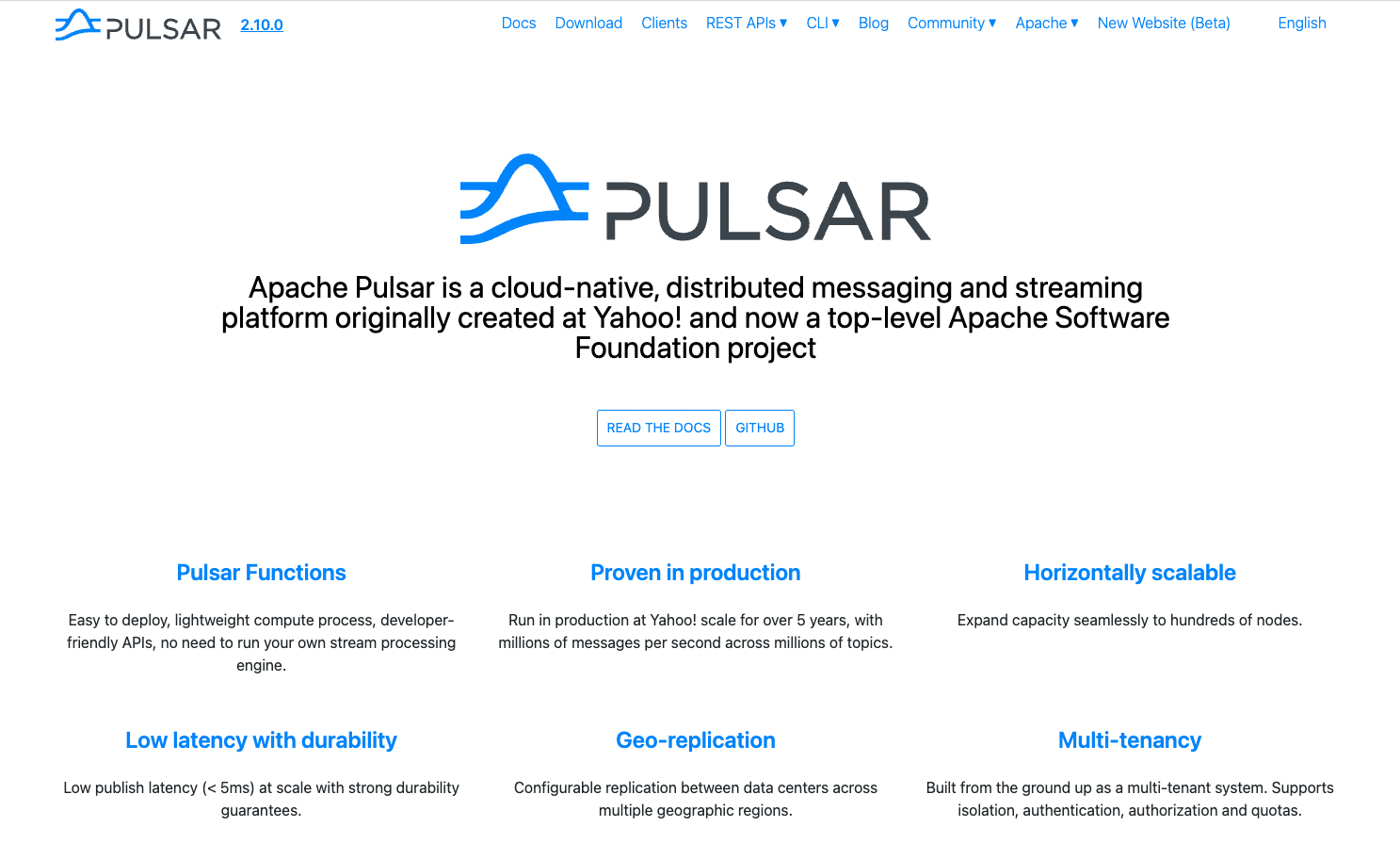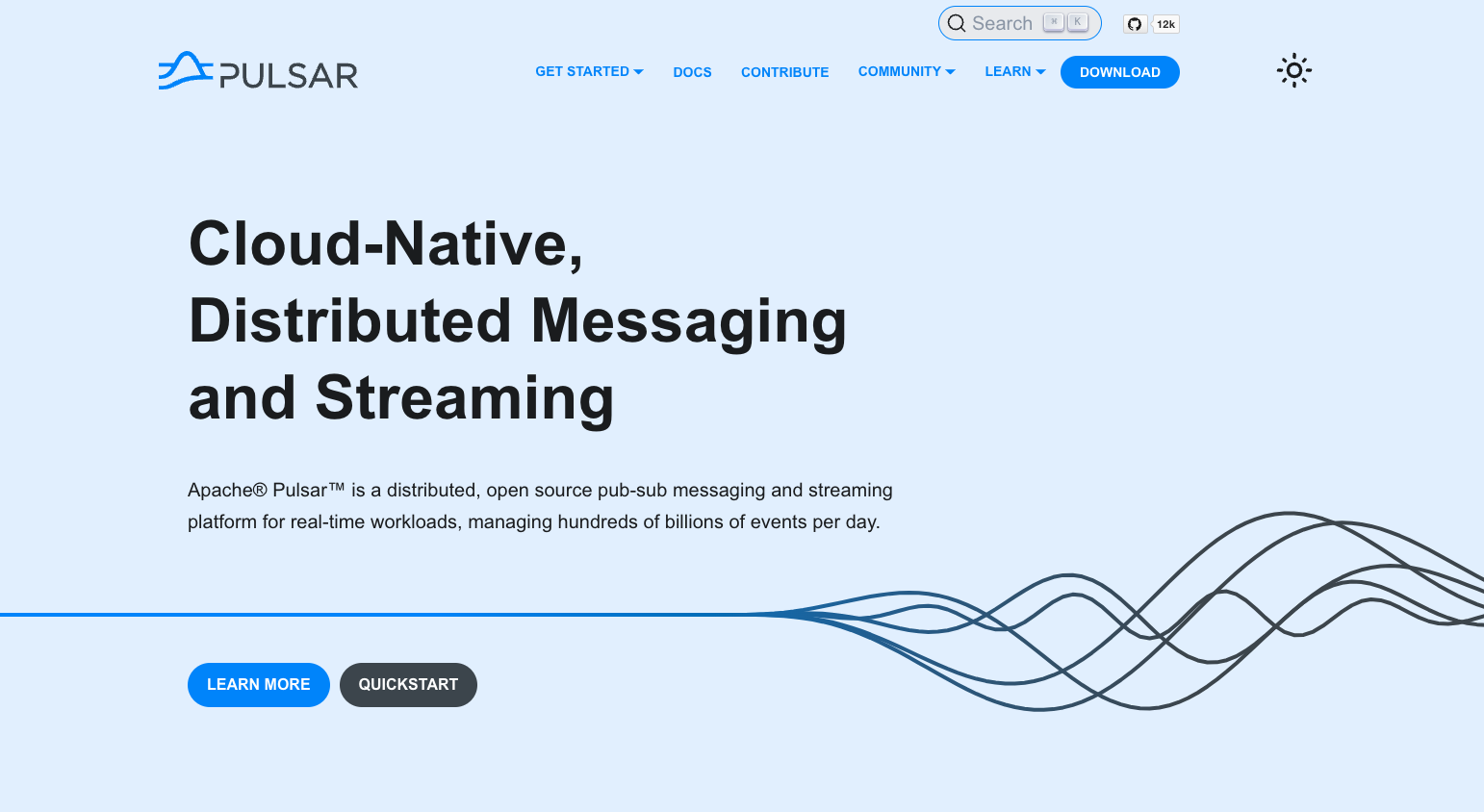2022 was an incredible year for Apache Pulsar as it witnessed strong community growth with the project becoming more stable, scalable, and secure.
We are grateful to all of our community members and those in the wider open-source community who contributed to the project. They are the reasons behind every step Pulsar has made over the past year.
Now, let’s take a look at some of the highlights in 2022.
New Pulsar website
In May 2022, the Apache Pulsar community launched its new website. The new appearance has a light blue background with the homepage structure redesigned. You can see PIP-87 and PIP-113 for more details. Following is a comparison of the websites.
Before:

After:


Many community members participated in the discussion and provided valuable feedback. Currently, the Pulsar community is still working to improve the reader experience by making key information more visible and accessible.
Key events recap
In 2022, the Apache Pulsar community put together a number of meetups and events across the globe to share the latest messaging and streaming technologies. Among others, two Pulsar Summits received the most attention from community members.
- Pulsar Summit San Francisco 2022: This event marked the first-ever, in-person Pulsar Summit in North America with 200+ attendees. It featured 20 speakers from companies like Google, AWS, and Yahoo!, 5 keynotes on Apache Pulsar and other streaming technologies, and 12 breakout sessions on tech deep dives, use cases, and ecosystem talks. Watch the sessions.
- Pulsar Summit Asia 2022: With 1,500+ registrations and 40,000+ views globally, this two-day virtual event gathered 41 speakers giving 3 keynote addresses and 36 sessions. They came from companies like ByteDance, Huawei, Tencent, Nippon Telegraph and Telephone Corporation (NTT), Yum China, Netease, vivo, Nutanix, and StreamNative. Watch the sessions.
To stay up to date with the latest events, you can join the following meetups or groups:
- New York City Apache Pulsar Meetup
- SF Bay Area Apache Pulsar Meetup
- Netherlands Apache Pulsar Meetup
- Japan Pulsar User Group
Community growth
The development of the Pulsar community would not be possible without our contributors. Among them, Pulsar Committers and PMC members have taken the lead in contributing to and promoting the project. In 2022, many new faces joined the community while we also welcomed old friends taking more responsibility. Let’s take a look at the Pulsar community by numbers.
- 598 global contributors for the Pulsar main GitHub repository
- 12.1K+ GitHub stars
- 3.2K+ forks
- 16 new Committers
- 5 new PMC members
- 9560 Pulsar Slack members
- 4.3K+ downloads
- 14M+ Docker pulls
The Pulsar community welcomes all kinds of contributions. For more information, see the Apache Pulsar Contribution Guide.
Project releases
In 2022, the Pulsar community worked hard to improve the project’s capabilities and fix existing bugs with 1 major version and 8 minor versions. Many important Pulsar capabilities were delivered in these releases, such as cluster-level automatic failure recovery and lazy-loading added to PartitionedProducer. Check out each release below to see details:
For more information, see the Release Notes page.
Updates about clients, Pulsar Manager, and Pulsar Helm Chart are listed below:
- Pulsar C++ Client 3.1.0
- Pulsar C++ Client 3.0.0
- Pulsar Go Client 0.9.0
- Pulsar Go Client 0.8.1
- Pulsar Go Client 0.8.0
- Pulsar Node.js Client 1.7.0
- Pulsar Node.js Client 1.6.2
- Pulsar Python Client 3.0.0
- Reactive Client for Apache Pulsar 0.1.0
- Pulsar Manager 0.3.0
- Pulsar Helm Chart 3.0.0
For more information, see the Clients Release Notes page.
Pulsar ecosystem
In 2022, the Pulsar community worked with other open-source communities to add more integrations to the Pulsar ecosystem. Notable integrations include:
- Spring for Apache Pulsar: This project aims to provide Spring-friendly APIs, building blocks, and programming models for writing Java applications that interact with Apache Pulsar. For more information, read the blog Spring for Apache Pulsar 0.1.0 available now.
- Flink-Pulsar Sink Connector: The Flink-Pulsar Sink Connector is part of the Flink-Pulsar DataStream Connector. It implements Flink’s new SinkV2 API and allows you to write Flink job results back to Pulsar topics seamlessly.
- HTTP Sink Connector: The HTTP Sink Connector pushes records to any HTTP server with the record value in the body of POST method. The body of the HTTP request is the JSON representation of the record value.
For more information, see the Ecosystem page.
What’s next in 2023
The Pulsar community seeks to further improve the project from different aspects. For example, we plan on releasing the first long-term support (LTS) version of Pulsar to meet the needs of different users. For those who want a more stable Pulsar version, they can choose the LTS release. The Pulsar community will help improve and upgrade the LTS versions with bug fixes and security patches.
Additionally, we will also have more events coming for 2023, including Pulsar Summit North America and Pulsar Summit APAC. To stay up to date with community news and discuss hot topics with other members, you can subscribe to the Pulsar mailing lists for users and developers, follow us on Twitter, and join the Pulsar Slack workspace.